| Listing 1 - 10 of 143 | << page >> |
Sort by
|
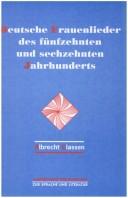
ISBN: 9004654933 9042004428 Year: 1998 Publisher: Amsterdam ; Atlanta, GA : Brill,
Abstract | Keywords | Export | Availability | Bookmark
 Loading...
Loading...Choose an application
- Reference Manager
- EndNote
- RefWorks (Direct export to RefWorks)
Diese Edition präsentiert zum ersten Mal sogenannte Frauenlieder des fünfzehnten und sechzehnten Jahrhunderts, die, soweit es sich heute noch sagen läßt, wahrscheinlich in der Tat von Frauen verfaßt wurden. Diese Frauenlieder, weitgehend in Liederbüchern enthalten, haben bis heute praktisch noch nicht die Aufmerksamkeit der Forschung auf sich gelenkt, was ihrer Entdeckung ein besonderes Gewicht verleiht. Obwohl uns bisher noch der letzte Beweis für die Behauptung fehlt, daß Frauen als die Verfasserinnen bezeichnet werden können, weil die Lieder alle anonym aufgezeichnet wurden, weisen doch sowohl die Liedinhalte als auch die Selbstbezeichnungen der Sängerinnen darauf hin, daß dies der Fall gewesen sein wird. Die Edition beruht auf umfangreichen Archivforschungen und bietet Frauenlieder, die uns entschieden dazu drängen, die Rolle von Frauen im frühneuzeitlichen literarischen Diskurs über Liebe neu zu interpretieren. Wie immer man die Gattung beurteilen wird, so liegt doch fest, daß diese Frauenlieder an erster Stelle für ein weibliches Publikum gedacht waren, das mit diesen Texten seine individuelle Anliegen, Sorgen, Erfahrungen und Hoffnungen auszudrücken vermochte. Diese Anthologie demonstriert zudem, daß die mittelhochdeutsche Liedgattung Frauenlied eine erstaunlich lange Tradition bis weit in die Frühneuzeit erlebte, obwohl die hier vorgestellten Liedtexte einen entschiedenen, vielleicht als typisch weiblich zu bezeichnenden Tonfall und ein neuartiges Selbstbewußtsein reflektieren.
Songs, German --- Women --- Songs in literature.
Book
ISBN: 9783110184099 9783110215588 3110215586 1282934007 9781282934009 3110184095 9786612934001 661293400X Year: 2010 Publisher: Berlin: de Gruyter,
Abstract | Keywords | Export | Availability | Bookmark
 Loading...
Loading...Choose an application
- Reference Manager
- EndNote
- RefWorks (Direct export to RefWorks)
Dieses interdisziplinäre Handbuch informiert umfassend über die mediävistische Forschung der letzten Jahrzehnte und ihre wichtigsten Ergebnisse. Es stellt ein Referenzwerk dar, das es ermöglicht, sich rasch und gezielt in wichtige Forschungsdiskurse einzuarbeiten und den Stand der Forschung zu rezipieren. Das englischsprachige, von einem internationalen Kollegium aus Fachgelehrten verfasste Handbuch ist vierteilig: Eine erste große Rubrik bietet Artikel zu allen wichtigen Wissensfeldern und -diskursen. Hier finden sich präzise Forschungsberichte etwa zu den Themen 'Arabische Literatur', 'Epigraphik', 'Kreuzzug' oder 'Deutsche Literatur'. Nicht die Sachen selbst werden erklärt, sondern es wird jeweils eine Perspektive auf die Forschung und ihre zentralen Fragestellungen und Kontroversen geboten. Eine zweite Rubrik bietet Artikel zu Leittermini der modernen Mediävistik und ihrer Debatten, z. B. 'Text', 'Performanz', 'Mündlichkeit/Schriftlichkeit' usw. Die dritte Rubrik ist ein Lexikon der wichtigsten Textgattungen des Mittelalters, z. B. 'Bibeldichtung', 'Chroniken', 'Visionsliteratur' usw. Die vierte Rubrik schließlich bietet ein internationales bio-bibliographisches Lexikon der wichtigsten Mediävisten aller Disziplinen von Guido Adler bis Paul Zumthor. Eine reichhaltige Gesamtbibliographie rundet das Kompendium ab. Damit liegt ein Referenzwerk vor, das den Stand der mediävistischen Forschung erschöpfend dokumentiert und die Disziplinen und Wissenschaftler des Faches zusammenführt. Das Lexikon ist unverzichtbar für jeden Mediävisten, der sich über die Forschung in seinem Arbeitsfeld zuverlässig und ausführlich informieren und einen Einstieg in die Fachliteratur gewinnen will.
History as a science --- Literature --- anno 500-1499 --- Middle Ages --- Literature, Medieval --- Medievalists --- Historiography --- Study and teaching --- History and criticism --- 930.21 "04/14" --- 940.1 <01> --- Historiografie: Middeleeuwen --- Geschiedenis van Europa: Middeleeuwen:--(ca.375-1492)--Bibliografieën. Catalogi --- 940.1 <01> Geschiedenis van Europa: Middeleeuwen:--(ca.375-1492)--Bibliografieën. Catalogi --- 930.21 "04/14" Historiografie: Middeleeuwen --- Dark Ages --- History, Medieval --- Medieval history --- Medieval period --- World history, Medieval --- World history --- Civilization, Medieval --- Medievalism --- Renaissance --- Mediaevalists --- Historians --- History --- History and criticism. --- Historiography. --- Study and teaching. --- Middle Ages - Historiography --- Middle Ages - Study and teaching --- Literature, Medieval - History and criticism --- Middle Ages - Bibliography --- Medievalists - Biography --- Littérature médievale --- Littérature médiévale --- Médiévistes --- MOYEN AGE --- Histoire et critique --- Bibliographie --- Biographies --- HISTORIOGRAPHIE --- ETUDE ET ENSEIGNEMENT --- Medieval Studies. --- Middle Ages.
Multi
ISSN: 18643396 ISBN: 9783110328783 311032878X 3110321513 9783110321517 Year: 2013 Volume: 14 Publisher: Berlin: de Gruyter,
Abstract | Keywords | Export | Availability | Bookmark
 Loading...
Loading...Choose an application
- Reference Manager
- EndNote
- RefWorks (Direct export to RefWorks)
This volume explores the surprisingly intense and complex relationships between East and West during the Middle Ages and the early modern world, combining a large number of critical studies representing such diverse fields as literary (German, French, Italian, English, Spanish, and Arabic) and other subdisciplines of history, religion, anthropology, and linguistics. The differences between Islam and Christianity erected strong barriers separating two global cultures, but, as this volume indicates, despite many attempts to 'Other' the opposing side, the premodern world experienced an astonishing degree of contacts, meetings, exchanges, and influences. Scientists, travelers, authors, medical researchers, chroniclers, diplomats, and merchants criss-crossed the East and the West, or studied the sources produced by the other culture for many different reasons. As much as the theoretical concept of 'Orientalism' has been useful in sensitizing us to the fundamental tensions and conflicts separating both worlds at least since the eighteenth century, the premodern world did not quite yet operate in such an ideological framework. Even though the Crusades had violently pitted Christians against Muslims, there were countless contacts and a palpitable curiosity on both sides both before, during, and after those religious warfares.
History of civilization --- World history --- East and West --- Middle Ages --- Literature, Medieval --- History --- Historiography --- History and criticism --- Europe --- Asia --- Relations --- East and West. --- Literature, Medieval. --- International relations. --- Kulturkontakt --- Internationella relationer --- Kulturmöten --- Historiografi. --- Litteratur --- Historiography. --- History and criticism. --- historia. --- To 1500. --- Medeltiden. --- Före 1800. --- Asia. --- Europe. --- Europa --- Orient --- Europa. --- Asien. --- Kulturkontakt. --- Orient. --- Asia -- Relations -- Europe. --- East and West -- History -- To 1500. --- Europe -- Relations -- Asia. --- Literature, Medieval -- History and criticism. --- Middle Ages -- Historiography. --- History & Archaeology --- History - General --- Civilization, Western --- Civilization, Oriental --- Occident and Orient --- Orient and Occident --- West and East --- Asian influences --- Oriental influences --- Western influences --- Medievalists --- Eastern question --- East and West - History - To 1500 --- Middle Ages - Historiography --- Literature, Medieval - History and criticism --- Europe - Relations - Asia --- Asia - Relations - Europe --- East-west contacts. --- interculturality. --- orientalism. --- toleration.
Book
ISBN: 9783110245479 9783110245486 3110245477 3110245485 1282885154 9786612885150 9781282885158 Year: 2010 Volume: 5 Publisher: New York : Walter de Gruyter,
Abstract | Keywords | Export | Availability | Bookmark
 Loading...
Loading...Choose an application
- Reference Manager
- EndNote
- RefWorks (Direct export to RefWorks)
Despite popular opinions of the 'dark Middle Ages' and a 'gloomy early modern age,' many people laughed, smiled, giggled, chuckled, entertained and ridiculed each other. This volume demonstrates how important laughter had been at times and how diverse the situations proved to be in which people laughed, and this from late antiquity to the eighteenth century. The contributions examine a wide gamut of significant cases of laughter in literary texts, historical documents, and art works where laughter determined the relationship among people. In fact, laughter emerges as a kaleidoscopic phenomenon reflecting divine joy, bitter hatred and contempt, satirical perspectives and parodic intentions. In some examples protagonists laughed out of sheer happiness and delight, in others because they felt anxiety and insecurity. It is much more difficult to detect premodern sculptures of laughing figures, but they also existed. Laughter reflected a variety of concerns, interests, and intentions, and the collective approach in this volume to laughter in the past opens many new windows to the history of mentality, social and religious conditions, gender relationships, and power structures.
Theory of knowledge --- humor --- epistemology --- Affective and dynamic functions --- Art --- Literature --- anno 500-1499 --- anno 1500-1599 --- Laughter in literature. --- Humor in literature. --- Laughter --- Wit and humor, Medieval. --- Wit and humor --- Rire dans la littérature --- Humour dans la littérature --- Rire --- Humour médiéval --- Humour --- History. --- Philosophy. --- Religious aspects. --- History and criticism. --- Histoire --- Philosophie --- Aspect religieux --- Histoire et critique --- Laughter -- History. --- Laughter -- Philosophy. --- Laughter -- Religious aspects. --- Wit and humor -- History and criticism. --- Wit and humor -- History. --- Laughter in literature --- Humor in literature --- Wit and humor, Medieval --- Languages & Literatures --- Literature - General --- History --- Philosophy --- Religious aspects --- History and criticism --- Rire dans la littérature --- Humour dans la littérature --- Humour médiéval --- Laughter (in religion, folk-lore, etc.) --- Laughing --- Bons mots --- Facetiae --- Humor --- Jests --- Jokes --- Ludicrous, The --- Ridiculous, The --- Wit and humor, Primitive --- Emotions --- Nonverbal communication --- Joking --- Laughter / in Literature. --- lachen
Book
ISBN: 9783110436976 9783110442304 9783110434873 3110442302 3110436973 3110434873 9783110436983 3110436981 Year: 2016 Publisher: Berlin, [Germany] ; Boston, [Massachusetts] : De Gruyter,
Abstract | Keywords | Export | Availability | Bookmark
 Loading...
Loading...Choose an application
- Reference Manager
- EndNote
- RefWorks (Direct export to RefWorks)
Death is not only the final moment of life, it also casts a huge shadow on human society at large. People throughout time have had to cope with death as an existential experience, and this also, of course, in the premodern world. The contributors to the present volume examine the material and spiritual conditions of the culture of death, studying specific buildings and spaces, literary works and art objects, theatrical performances, and medical tracts from the early Middle Ages to the late eighteenth century. Death has always evoked fear, terror, and awe, it has puzzled and troubled people, forcing theologians and philosophers to respond and provide answers for questions that seem to evade real explanations. The more we learn about the culture of death, the more we can comprehend the culture of life. As this volume demonstrates, the approaches to death varied widely, also in the Middle Ages and the early modern age. This volume hence adds a significant number of new facets to the critical examination of this ever-present phenomenon of death, exploring poetic responses to the Black Death, types of execution of a female murderess, death as the springboard for major political changes, and death reflected in morality plays and art.
History of civilization --- anno 1600-1699 --- anno 1500-1599 --- Europe --- Middle Ages. --- Material culture --- Death in art. --- Death in literature. --- Moyen Age --- Culture matérielle --- Mort dans l'art --- Mort dans la littérature --- History. --- Histoire --- History --- Social life and customs. --- Religious life and customs. --- Intellectual life. --- Moeurs et coutumes --- Vie religieuse --- Vie intellectuelle --- Culture matérielle --- Mort dans la littérature --- Death --- Middle Ages --- Death in art --- Death in literature --- Social aspects&delete& --- Religious aspects&delete& --- Culture --- Folklore --- Technology --- Dark Ages --- History, Medieval --- Medieval history --- Medieval period --- World history, Medieval --- World history --- Civilization, Medieval --- Medievalism --- Renaissance --- 930.86.01 --- 393 --- 393 Dood. Dodengebruiken. Dodenritueel. Lijkverbranding. Begrafenis. Crematie. Rouw. Opbaren. Lijkstoet. Sterven. Dodenmaskers --- Dood. Dodengebruiken. Dodenritueel. Lijkverbranding. Begrafenis. Crematie. Rouw. Opbaren. Lijkstoet. Sterven. Dodenmaskers --- 393 Death. Treatment of corpses. Funerals. Death rites --- Death. Treatment of corpses. Funerals. Death rites --- 930.86.01 Mentaliteitsgeschiedenis:--Middeleeuwen --- Mentaliteitsgeschiedenis:--Middeleeuwen --- Dying --- End of life --- Life --- Terminal care --- Terminally ill --- Thanatology --- Philosophy --- Social aspects --- Religious aspects
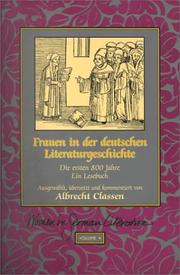
ISBN: 0820441090 Year: 2000 Volume: 4 Publisher: New York (N.Y.) : Lang,
Abstract | Keywords | Export | Availability | Bookmark
 Loading...
Loading...Choose an application
- Reference Manager
- EndNote
- RefWorks (Direct export to RefWorks)
German literature: authors --- anno 500-1499 --- anno 1500-1799 --- German literature --- Women authors. --- Women authors
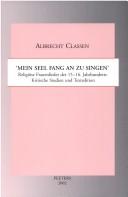
ISBN: 9042910984 9789042910980 Year: 2002 Volume: 6 Publisher: Leuven: Peeters,
Abstract | Keywords | Export | Availability | Bookmark
 Loading...
Loading...Choose an application
- Reference Manager
- EndNote
- RefWorks (Direct export to RefWorks)
Liturgy --- Music --- Christian spirituality --- anno 1400-1499 --- anno 1500-1599 --- Chants religieux --- Religieuze liederen --- German poetry --- History and criticism --- Early modern, 1500-1700 --- Christian poetry, German --- Women and literature --- History --- 16th century --- Germany --- To 1500 --- History and criticism. --- Women authors --- German poetry - Women authors - History and criticism --- German poetry - Early modern, 1500-1700 - History and criticism --- Christian poetry, German - Early modern, 1500-1700 - History and criticism --- Women and literature - Germany - History - 16th century --- Women and literature - Germany - History - To 1500 --- German poetry - Early modern, 1500-1700 --- Christian poetry, German - Early modern, 1500-1700

ISBN: 9042004428 Year: 1999 Volume: 136 Publisher: Amsterdam ; Atlanta Rodopi
Abstract | Keywords | Export | Availability | Bookmark
 Loading...
Loading...Choose an application
- Reference Manager
- EndNote
- RefWorks (Direct export to RefWorks)
Poetry --- German literature --- Music --- Sociology of literature --- anno 1400-1499 --- anno 1500-1599 --- Songs [German ] (Middle High German) --- Women authors
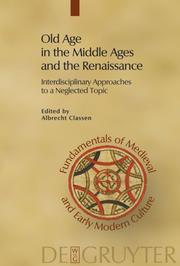
ISBN: 9783110195484 3110195488 3110925990 9783110925999 Year: 2007 Volume: 2 Publisher: Berlin ; New York : Walter de Gruyter,
Abstract | Keywords | Export | Availability | Bookmark
 Loading...
Loading...Choose an application
- Reference Manager
- EndNote
- RefWorks (Direct export to RefWorks)
After an extensive introduction that takes stock of the relevant research literature on Old Age in the Middle Ages and the early modern age, the contributors discuss the phenomenon of old age in many different fields of late antique, medieval, and early modern literature, history, and art history. Both Beowulf and the Hildebrandslied, both Wolfram von Eschenbach's Parzival and Titurel, both the figure of Merlin and the trans-European tradition of Perceval/Peredur/Parzival, then the figure of the vetula in a variety of medieval French, English, and Spanish texts, and of the Old Man in The Stricker's Daniel, both the treatment of old age in Langland's Piers the Plowman and in Jean Gerson's sermons are dealt with. Other aspects involve late-antique epistolary literature, early modern French farce in light of Disability Studies, the social role of old, impotent men in sixteenth- and seventeenth-century Netherlandish paintings, and the scientific discourse of old age and health since the 1500's. The discourse of Old Age proves to have been of central importance throughout the ages, so the critical examination of the issues involved sheds intriguing light on the cultural history from late antiquity to the seventeenth century.
Comparative literature --- Thematology --- anno 500-1499 --- anno 1500-1599 --- Europe --- European literature --- Literature, Medieval --- Old age in literature --- Old age --- Later life (Human life cycle) --- Senescence --- Adulthood --- Age --- Longevity --- Older people --- Older people in literature --- History and criticism --- History --- Old age in literature. --- History and criticism. --- History. --- Early Modern Age. --- Late Antiquity. --- Literature, History, and Art History. --- Middle Ages. --- Old Age Studies.
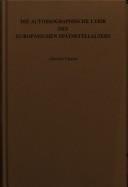
ISBN: 9051832486 Year: 1991 Volume: vol 91 Publisher: Amsterdam Atlanta Rodopi
Abstract | Keywords | Export | Availability | Bookmark
 Loading...
Loading...Choose an application
- Reference Manager
- EndNote
- RefWorks (Direct export to RefWorks)
Autobiografie --- Autobiographie --- Autobiography --- Medieval poetry --- Middeleeuwse poëzie --- Poetry [Medieval ] --- Poésie médiévale --- Poëzie [Middeleeuwse ] --- LYRIQUE AUTOBIOGRAPHIQUE --- MOYEN AGE
| Listing 1 - 10 of 143 | << page >> |
Sort by
|

 Search
Search Feedback
Feedback About UniCat
About UniCat  Help
Help News
News